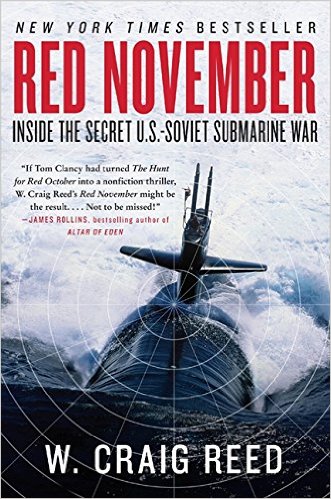 This is an absolutely fascinating book that turned up in the
Used Military Books Room a few years ago. Even though it was published
relatively recently, it seems to be hard to find.
This is an absolutely fascinating book that turned up in the
Used Military Books Room a few years ago. Even though it was published
relatively recently, it seems to be hard to find. This is an absolutely fascinating book that turned up in the
Used Military Books Room a few years ago. Even though it was published
relatively recently, it seems to be hard to find.
This is an absolutely fascinating book that turned up in the
Used Military Books Room a few years ago. Even though it was published
relatively recently, it seems to be hard to find.
Reviewers have compared this book to Tom Clancy's Red October, but this book is not fiction. It is partly biography and partly autobiography, based on personal experiences and first-hand interviews.
The biographical part concerns the author's father, Lt. William J. Reed, who was deeply involved in the development and subsequent upgrading of the U.S. Navy's radio direction finding systems for locating Soviet submarines -- just in time for the Cuban missile crisis of October 1962. The Soviets sent four submarines armed with nuclear-tipped torpedoes into the area, and finding and neutralizing these four submarines therefore became the U.S. Navy's top priority. This they were able to do, but when finally cornered the captains of these submarines chose not to use their nuclear weapons, but chose rather to admit defeat and return home. And the U.S. Navy let them go.
The next part of the book chronicles some of the major submarine-related incidents of the Cold War, including the Thresher disaster, the Pueblo incident, the sinking of USS Sturgeon, and the attempts by Glomar Explorer to recover the sunken Soviet submarine K129. All of these incidents have been reported previously, but the author's detailed recounting is enhanced by interviews with personnel who were directly involved.
The author then moves on to discuss the super-secret Ivy Bells and Holystone missions, so dangerous -- technically, operationally and politically -- that each mission required the personal approval of the President. The Ivy Bells missions, which began in the early 1970's, involved submarines going deep into Soviet territorial waters to rest on the sea floor at depths of up to several hundred feet, sometimes for many weeks, while saturation divers exited the submarine to tap Soviet undersea communications cables.
The Holystone missions also involved going deep into Soviet territorial waters to seek out Soviet submarines at close range to obtain intelligence information. By this time the author himself had become a submariner, and he was involved in one such mission in which his boat collided with a Soviet submarine, leading to their detection and subsequent very narrow escape from Soviet anti-submarine forces.
The final humanizing part of this narrative resulted from the author being invited to a reunion of Soviet submariners in St. Petersburg in 2009 where he met and befriended some of the Soviet submariners who were on the opposite side of many of the encounters chronicled in this book, and whom the author subsequently interviewed for this book.
Being himself a fire control tech, a diver and a submariner, and with extensive contacts in the "spook" world, the author writes with authority on these events; he is neither bombastic nor sensational: his story speaks for itself. Also, the extensive notes on each chapter reinforce the notion that this narrative is very solidly fact-based. Most highly recommended.
| Return to Table of Contents |
|
|
|
Last updated: 04 August 2016 |